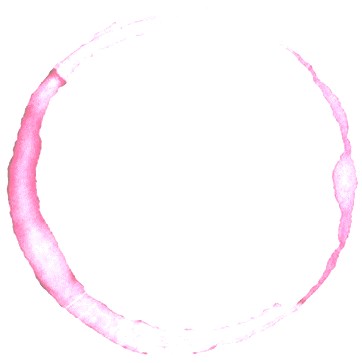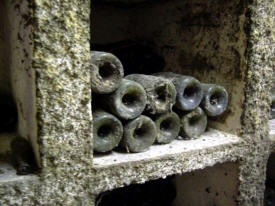
< Previous / Next >
 |
Article Index < Previous / Next > |

Wine cellar revelations
It’s been down there for years my friend. The label was a bit faded last time I saw it and you may need to move a few bottles but I think you’ll find it in the lower bin at the far end of the cellar. Just brush the dust off and bring it upstairs, I’ll bet it is drinking perfectly after all these years…
While perhaps not fully comprehendible in terms of
chemistry, the magical transformation that occurs within a bottle of wine as
it rests undisturbed in your cellar is one of life’s most underappreciated
mysteries. Wine enthusiasts have certainly grown to recognize the product of
quality versus time and those who exercise the necessary willpower of
patience also understand the significance of this century-old phenomenon.
 Historically,
the earliest examples of wine storage explore a combination of needs: a
surplus of quantity in a good year, a supply for shipment to a distant
region, and perhaps an inventory for religious need in the church. It is
doubtful that early inhabitants understood or could even anticipate the
evolution of wine. It is equally unlikely that vinous beverages showed even
the slightest signs of improvement when left unconsumed for a season or
longer. But as winemaking techniques continued to evolve over time,
logically the quality of the product did as well. More structure and
complexity also meant that a wine was not approachable immediately. Perhaps
early examples of intentional cellaring were the result of a newly crossed
grape’s tannic structure. Cabernet Sauvignon after all is a relatively young
variety, having been the product of a cross between Sauvignon Blanc and
Cabernet Franc. Did this new powerhouse grape catch its makers off guard
with its bold nature? Was the wine intentionally shelved out of concern for
its bold and structured characteristics only to become a much more pleasant
drink a year or two later? Of the thousands of wine labels available in
stores today, only a fraction will positively gain from additional time
spent in the bottle; most wine is best consumed young while it is fresh and
lively.
Historically,
the earliest examples of wine storage explore a combination of needs: a
surplus of quantity in a good year, a supply for shipment to a distant
region, and perhaps an inventory for religious need in the church. It is
doubtful that early inhabitants understood or could even anticipate the
evolution of wine. It is equally unlikely that vinous beverages showed even
the slightest signs of improvement when left unconsumed for a season or
longer. But as winemaking techniques continued to evolve over time,
logically the quality of the product did as well. More structure and
complexity also meant that a wine was not approachable immediately. Perhaps
early examples of intentional cellaring were the result of a newly crossed
grape’s tannic structure. Cabernet Sauvignon after all is a relatively young
variety, having been the product of a cross between Sauvignon Blanc and
Cabernet Franc. Did this new powerhouse grape catch its makers off guard
with its bold nature? Was the wine intentionally shelved out of concern for
its bold and structured characteristics only to become a much more pleasant
drink a year or two later? Of the thousands of wine labels available in
stores today, only a fraction will positively gain from additional time
spent in the bottle; most wine is best consumed young while it is fresh and
lively.
Wine storage is not a science but rather a necessity on the quest for
oenological pleasure. It is a minority that I reference both in terms of the
wine eligibility and personal desire. The practice of cellaring wine is
an art form and those able to grasp at the notion of laying a few bottles
down also have a vision which allows them to paint the pleasures of good
taste. Contrary to popular belief, cellaring wine does not require perfect
storage conditions; I'll explain...
I’ve been exploring this question for well over a decade by purchasing,
cellaring, and consuming bottles stored in a passive cellar not unlike that
which might have existed 200 years ago in Europe. Forgoing the option of
climate control for a simple thermometer, I watch and track the seasonal
trends in this old cavern, brushing away cobwebs to inspect bottles
purchased at point that seems like a lifetime ago. Indeed, the technology
does exist to create a sterile environment for bottle storage; one with
sensors, digital readouts, alarms, and even smart-phone tracking. Should the
temperature or humidity index fluctuate and exceed a preset limitation,
sophisticated back-up systems trigger to compensate and recover climatic
control.
If you detect a note of sarcasm, you’ll also understand where this
is going.
My cavern, if you will, lies beneath a brick home in the countryside an hour
north of Toronto. The structure rests upon a 3-foot-thick fieldstone
foundation and the cellar floor is simply what existed on this site when
they began construction 160 years ago – natural earth. It is consistently
cool in this unheated northeast corner room - but consistent implies a
constant state not a specific value. The temperature actually fluctuates
seasonally by approximately 5 degrees reaching 16˚C / 61˚F in the heat of
the summer and dipping down to 7 or 8 degrees in the frigid winter months.
For the majority of the year, this dungeon-like room sits at a median value
of 11˚C / 52˚F plus or minus a degree or two. If this seems a touch vague,
that is the whole idea; I have left nature to run its course, just as those
cellaring wine a hundreds of years ago did. When the power fails during an
ice storm, the wine sleeps on - and when and if our home's air conditioner decides to take the day off, the wine will remain comfortable cool.
The obvious response is that not everyone lives in an old
home and while that fact is noted, surprisingly it holds little importance; before this location, we were condo dwellers in the city. As budding
wine enthusiasts, our sun-filled home sat atop a 37 story building with
floor to ceiling windows. This was also prior to the popularity of wine
refrigerators that are now readily available at both department stores and
specialty wine shops. As for the variables of temperature, humidity,
vibration, and light, our collection of fine wine rested in a state of
climatic chaos. I’ll plead ignorance for 80 percent of the problem; I simply
didn’t know any better at the time. Our growing collection of bottles were
piled neatly on the floor in an alcove located at the base of the air
conditioning and heating unit - the thought literally sends shivers up my
spine as I write. But that was 15 years ago, and I know better now –
or at least I am a wiser man for the experience. The question remains
though, did the wine suffer as a result of my highly questionable storage
technique?
A month ago, a group of wine guru types gathered at a nearby dining
establishment to enjoy a good meal, great conversation, and a few special
bottles salvaged from their past. I happen to be the ring leader of this
consortium we like to call the North of 9 Fine Wine. The ante to play in our
game is that you must contribute a bottle of stature. Present at this
particular function were a bottle of ’99 Orneliaia, an ’85 Haut Brion, 1er
Cru Puligny-Montrachet from the house of Louis Jadot and a magnum of 1988
Dom Perignon from the condo of storage sins.
The Dom stares at me each time I enter the cellar; it
has for as long as I have owned this bottle. The old Monk is forever present
in my conscience, there to remind me of the neglect, taunting me and daring
me to uncage and pop the bottle for a house full of guest. How sweet would
revenge taste for the old cellar master from Hautvillers if I were to pour a
bottle of sour, stale, and lifeless Champagne for my guests?
Well dear friends, here is where we learn a little something about the
longevity of wine. The 1988 Dom Perignon was stunningly drinkable and full of
life as it lit up the room with endless strings of bubbles and the softest
most pure taste
possible from a bottle of wine, let alone 25 year old
Champagne. A friend sitting across the table from me refused to surrender
his empty glass to the waiter, opting instead to inhale the aromatic
sensations that continued to cling to the empty flute. He even went so far
as to proclaim the Champagne to be the greatest wine he had tasted to date;
I was not far behind him on that opinion either. But this is not a lesson on
how to appreciate Dom Perignon and I am of the strong opinion that Moёt et
Chandon’s flagship cuvée is grosly overpriced. That said, if you do have a
bottle in your cellar, consider tucking it away indefinitely - you will
not be disappointed.
What I intend for you to gain from this recollection is
that your collection of bottled treasures do not necessitate flawless
storage conditions. The magnum of Champagne was in perfect condition despite
having been violated in every possible way. Furthermore, nearly every bottle
that has endured our condominium’s treacherous environment has also provided
tremendous pleasure at the dinner table.
Storage for investment purposes is another issue completely; both
purveyor and buyer alike rely heavily upon a wine’s providence to ensure the
maximum return on a given investment. Not that the wine will taste any
better - it will not, but you must reduce the element of uncertainty to
appease the purchaser. Cellaring for personal consumption, while no less
important, is a different animal entirely, but do not think for a second
that the environment must be a sterile cold room, R60 insulated, and
monitored like a Swiss bank. That is overkill and the source of unnecessary
expense and headache.
The evolution of a bottle of wine is primarily a function of temperature.
Wine stored at a higher temperature will evolve faster while storage on the
cooler side of the spectrum simply means that you must wait longer to
partake. But you must also protect the process, for rapid fluctuations are
by far a wine’s worst enemy. Such extremes will cause fluid expansion and
eventually compromise the cork’s seal. Seasonal fluctuations on the other
hand are perfectly acceptable and will do no harm to the process. In terms
of relative humidity, guidelines suggest 55-75% for cellaring wine and
unless you live in some desert-like climate be it hot or cold, the moisture
content of your home is surprisingly more than adequate to preserve the
integrity of the cork for several years. Consider: The cooler the cellar,
the drier the resultant environment and the greater the need for
supplemental humidity. Darkness, or at least lack of direct sunlight is
essential to prevent unwanted chemical reactions and vibration should be
kept to a minimum. Additionally, the room does require a certain amount of
ventilation and harsh aromas should always be avoided.
If you are like most wine enthusiasts, then you want nothing more than to
enjoy your finest bottles several years down to road. There is no need to
over-prep for the occasion; just let the story unfold without interruption
and don’t get worked up if one variable changes slightly. It is somewhat
unfortunate that we have inadvertently turned the pleasure of cellaring wine
into a monumental task of unnecessary complexity. Can I suggest that you let
Mother Nature do her job, the same way she has done it for centuries.
return to the Article Index |
Tyler Philp is a member of the Wine Writers' Circle of Canada Please direct inquires for writing services to: info@tylerphilp.com |
| Copyright © 2013 Tyler Philp
prior permission required for duplication of material |